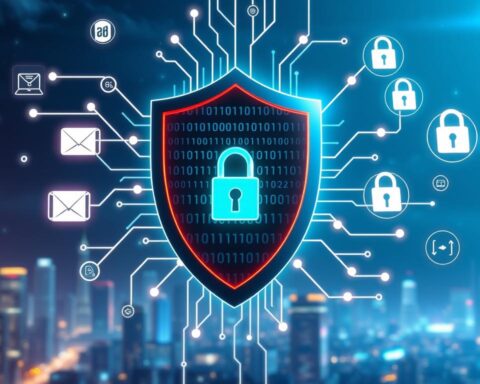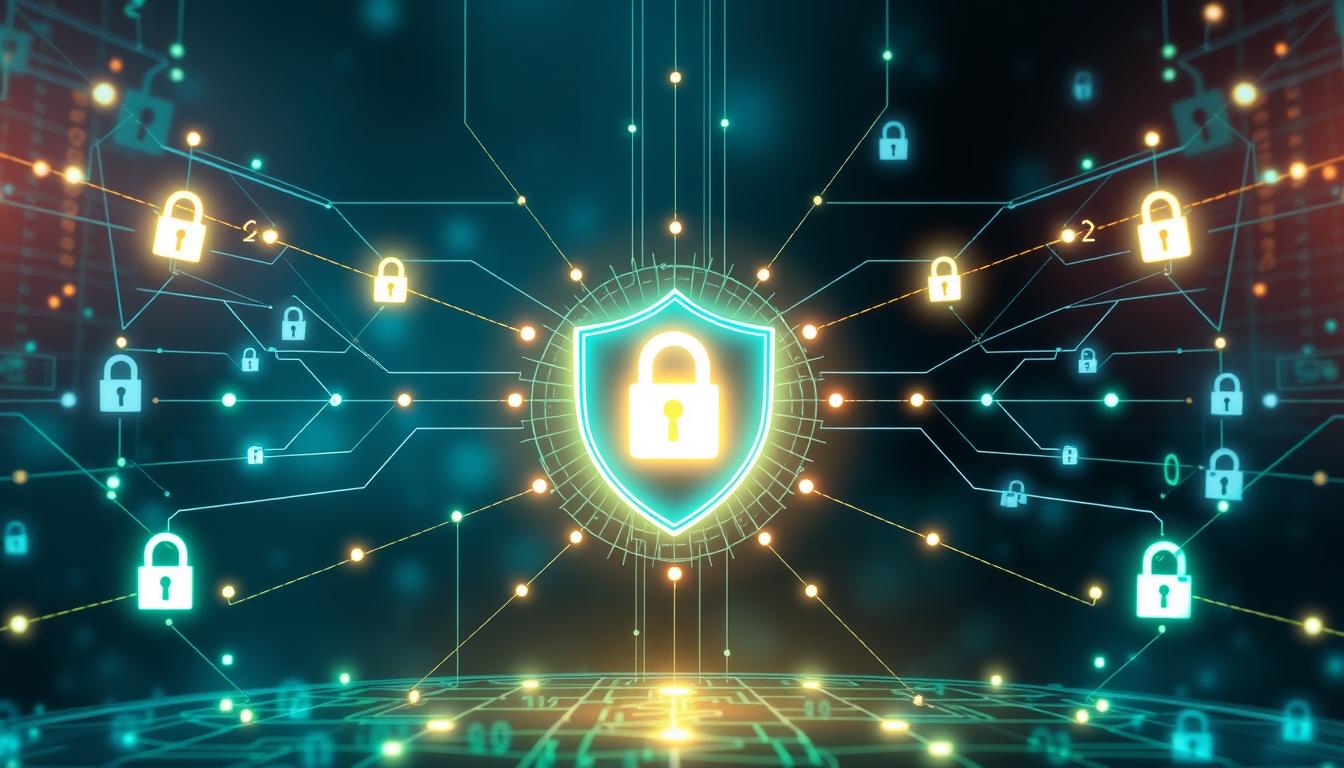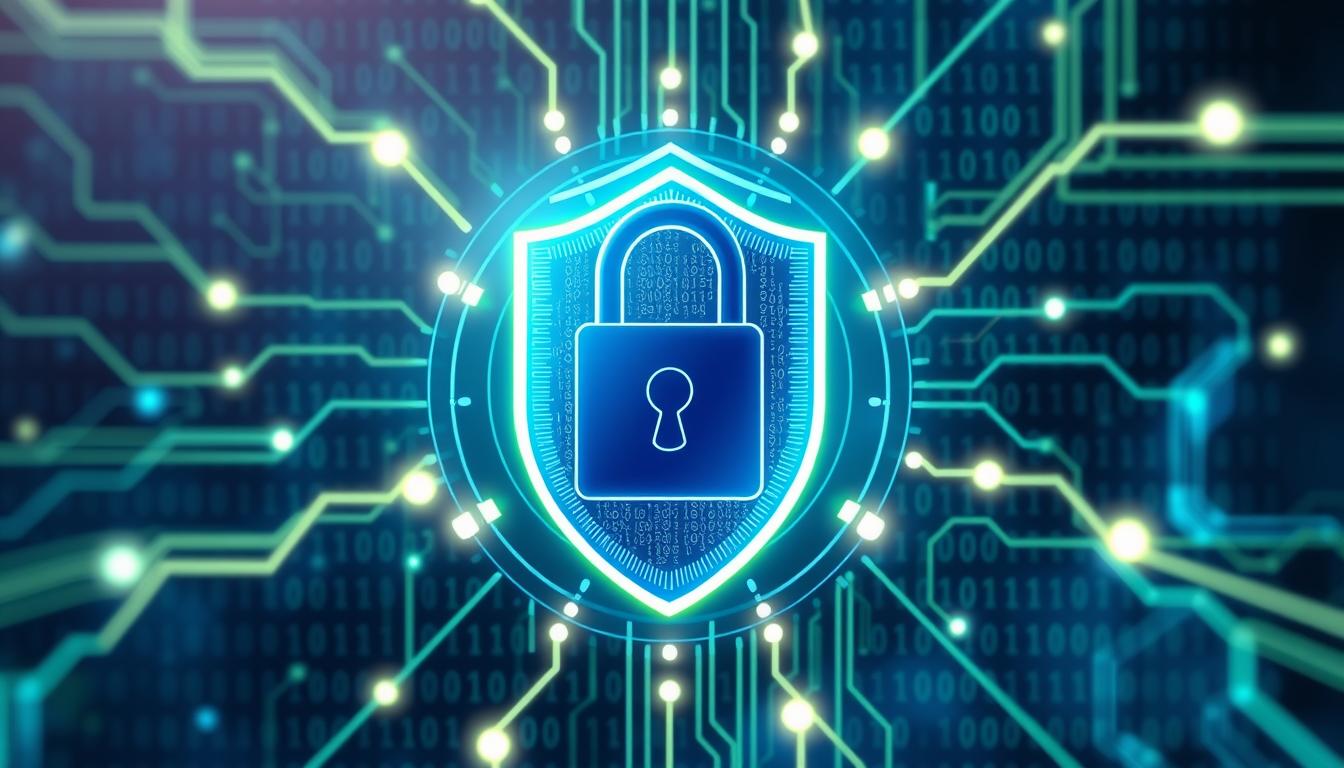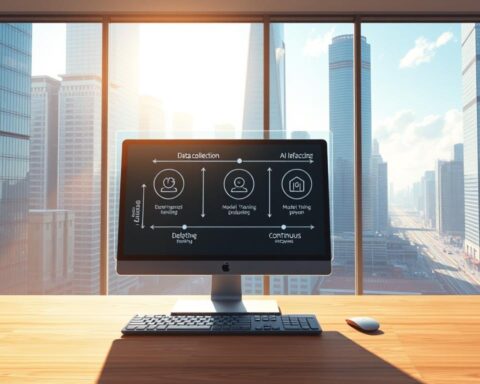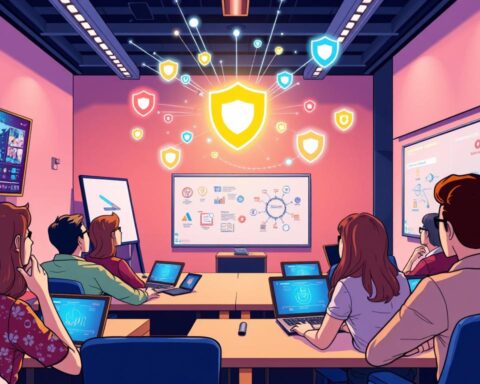Cybercrime is expected to cost the world $10.5 trillion by 20251. It’s vital to focus on online security and privacy every day. We need to know about cyber threats that can harm our personal and financial info. Experts say using multifactor authentication and avoiding suspicious links can help a lot.
Cyber threats are getting more common, with 50% of breaches caused by phishing and social engineering1. To stay safe, we should use strong passwords and keep our software updated. These habits can help protect us from cyber attacks and keep our online world secure.
Key Takeaways
- Cybercrime is a big threat to our online security and privacy
- Enabling multifactor authentication can reduce the risk of data breaches
- Being cautious of suspicious links and emails is key to preventing cyber attacks
- Implementing cybersecurity training can help fight cyber threats2
- Multi-layered cybersecurity measures can greatly lower successful breaches2
Understanding Modern Cyber Threats in Daily Life
Technology keeps getting better, but so do cyber threats. These threats are a big worry for both people and businesses. The internet is a dangerous place, and one mistake can cause a lot of harm. Studies show that about 90% of cyberattacks start with a phishing email3.
Cyber threats come in many forms, like malware, ransomware, and social engineering. These attacks try to trick people into giving away sensitive info4. It can take up to 150 days to find out if a breach has happened3. Knowing about these threats and how to protect yourself is key.
Some common cyber threats include:
- Phishing attacks, which are a big part of social engineering threats5
- Malware attacks, which include many kinds of harmful software5
- Ransomware attacks, which have increased by 41% in 20234
By knowing about cyber threats, you can protect yourself and your data. Be careful online, use antivirus software, and manage your passwords well. Cybercrime costs are expected to hit over $10 trillion by 20254.
It’s important to keep up with the latest cyber threats. Taking steps to protect yourself and your business can help. This way, you can lower the risk of cyber attacks and make the internet safer for everyone.
Essential Digital Security Habits
In today’s digital world, knowing about online security is key. With more threats online, it’s vital to have good habits. Using strong, unique passwords for all accounts is a must, as weak passwords are easy targets for hackers6. Also, turning on multifactor authentication (MFA) boosts security, stopping up to 99.9% of automated attacks6.
Being careful with links and attachments from unknown sources is another habit. These can be phishing scams7. Keeping your software updated is also important. Updates often fix security holes that hackers could use6. These habits help lower the risk of cyber attacks and keep you safer online.
To learn more about staying safe online, check out cybersecurity tips. Discover why cybersecurity awareness is so important in fighting online threats.
Some essential digital security habits include:
* Using strong, unique passwords for all accounts
* Enabling multifactor authentication (MFA)
* Being cautious with links and attachments from unknown sources
* Keeping software up to date
By following these habits and staying informed, you can protect yourself from cyber threats. This keeps your cybersecurity awareness high6.
Protecting Your Personal Information Online
Keeping your personal info safe online is key in today’s world. Digital privacy is a big deal. About 30% of Americans have faced identity theft at some point8. To avoid this, using strong passwords and two-factor authentication is vital. Almost 70% of data breaches come from stolen login details8.
Creating strong, unique passwords and using a password manager is a big step. Two-factor authentication can stop almost all automated cyberattacks8. Also, watch out for phishing emails and make sure websites are secure. For more tips, check out this resource.
Here are some ways to keep your info safe online:
- Use strong, unique passwords for each account
- Turn on two-factor authentication whenever you can
- Be careful with phishing emails and odd messages
- Keep your security software and operating systems up to date
By using these tips, you can greatly lower the chance ofidentity theft and keep yourdigital privacy safe8.
Safeguarding Your Devices from Malware
To keep your devices safe from malware, it’s key to have strong malware protection. This means keeping your software current and using antivirus software9. This is vital for internet safety because more devices are connected to the internet. This makes our personal info more at risk for theft and fraud9.
Here are some important steps to protect your devices:
- Use strong, unique passwords to boost security against threats10
- Turn on two-factor authentication to stop automated attacks on accounts9
- Update your device’s operating system and apps often to fix security holes10
- Use antivirus and antimalware software to fight off bad software10
By following these steps, you can shield your devices from malware. This helps lower the chance of cyber attacks, keeping your internet safety and security strong9. It’s also smart to stay updated on new cyber threats and trends. For example, mobile device malware attacks have jumped by over 50% in the last three years9.
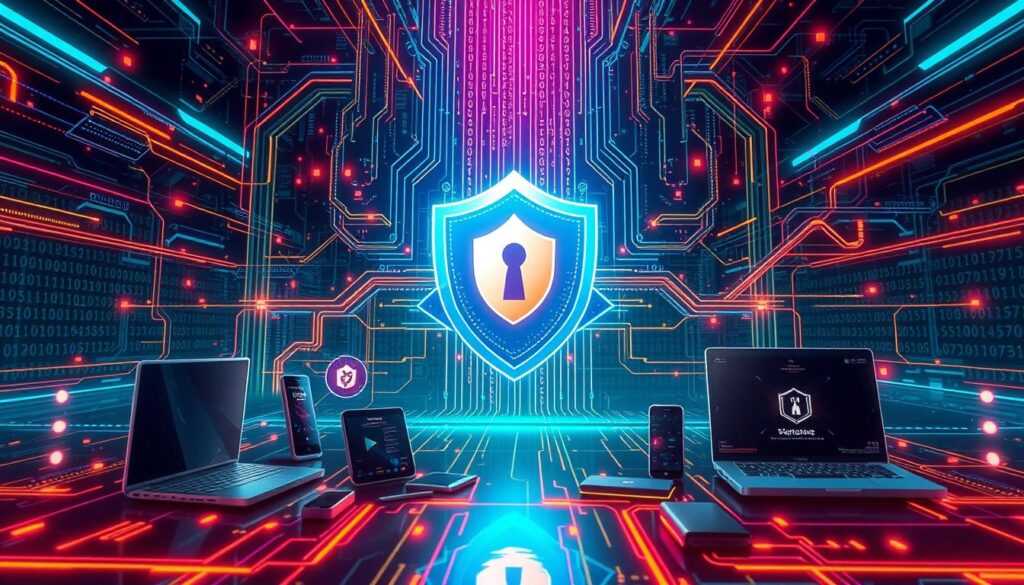
Recognizing and Avoiding Phishing Attempts
Phishing attempts are a common cyber attack that can cause big problems. They often target personal info like account numbers and passwords. This can lead to identity theft and harm your financial history for years11.
These attacks are getting smarter, with scammers sending out thousands of phishing emails daily. They often use current news or trends to trick people12.
To stay safe from phishing, be careful with emails or messages asking for personal info. Legit companies won’t ask for payment info through emails or texts12. Also, using multi-factor authentication can greatly lower the risk of account hacks. Accounts with this feature are 99.9% less likely to be compromised12.
Here are some steps to take if you think you’re being phished:
- Check if the message is real by calling the company directly
- Don’t click on weird links or open attachments from unknown senders
- Use strong, unique passwords and keep your software updated
By knowing about phishing tactics and taking steps to protect yourself, you can lower your risk of cyber attacks and data breaches.
Conclusion: Strengthening Your Digital Security Footprint
In today’s digital world, keeping our data safe is key. We must focus on cybersecurity awareness and act to protect our personal and financial info. Knowing how to stay safe online can help us avoid cyber attacks. Cybercriminals use our online tracks to target us with scams13.
Our digital trail is made up of all our online actions. This includes social media posts, online shopping, and signing up for newsletters13. To lower the risk, we should be careful with our online presence. This means not sharing too much personal info, using strong passwords, and turning on Multi-Factor Authentication (MFA) when we can.
By keeping up with cyber threats and protecting ourselves, we can make our digital security stronger. A recent study found that 32% of people in the U.S. and U.K. had their social media logins stolen14.
By focusing on cybersecurity and protecting our digital privacy, we can lower the chance of cyber attacks. Using privacy settings can help reduce our digital footprint, but it might make some websites harder to use13.
FAQ
What are the most common types of cyber threats in daily life?
How do cybercriminals target everyday users?
What are the essential digital security habits to protect against cyber threats?
How can I protect my personal information online?
What are the best ways to safeguard my devices from malware?
How can I recognize and avoid phishing attempts?
Why is cybersecurity awareness important for individuals and businesses?
What are the benefits of using two-factor authentication?
How can I stay informed about the latest cyber threats?
Source Links
- Understand the Importance of Cyber Security: Guardian Against Threats! – https://www.simplilearn.com/tutorials/cyber-security-tutorial/what-is-cyber-security
- Cybersecurity | Be Ready Utah – https://beready.utah.gov/utah-hazards/cybersecurity/
- Cybersecurity Threats: What They Are & How They Work Today | Splunk – https://www.splunk.com/en_us/blog/learn/cybersecurity-threats.html
- What Is Cybersecurity? The Realities of the Digital Age – https://www.apu.apus.edu/area-of-study/information-technology/resources/what-is-cybersecurity-the-realities-of-the-digital-age/
- Types of Cyber Attacks & Cyber Threats Explained [2025] – https://www.simplilearn.com/tutorials/cyber-security-tutorial/types-of-cyber-attacks
- Good Security Habits | CISA – https://www.cisa.gov/news-events/news/good-security-habits
- Personal Digital Security 101: A Guide to Online Security and Privacy – https://ironvest.com/blog/personal-cyber-security-101-a-beginners-guide-to-internet-safety/
- Protect Your Personal Information From Hackers and Scammers – https://consumer.ftc.gov/articles/protect-your-personal-information-hackers-and-scammers
- Protect Your Computer From Viruses, Hackers, and Spies – https://oag.ca.gov/privacy/facts/online-privacy/protect-your-computer
- Cybersecurity Awareness: 4 Tips to Stay Safe Online – Seminole State College – https://www.seminolestate.edu/newsroom/article/6463/cybersecurity-awareness-4-tips-to-stay-safe-online
- Phishing Attack Prevention: How to Identify & Avoid Phishing Scams – https://www.occ.gov/topics/consumers-and-communities/consumer-protection/fraud-resources/phishing-attack-prevention.html
- How To Recognize and Avoid Phishing Scams – https://consumer.ftc.gov/articles/how-recognize-and-avoid-phishing-scams
- Strategies to Help Protect Your Digital Footprint | Morgan Stanley – https://www.morganstanley.com/articles/digital-footprint-protection-strategies
- What Is Digital Security? Steps to Stay Safe Online (NEW) – https://www.aura.com/learn/digital-security



